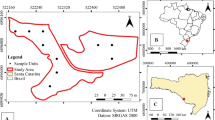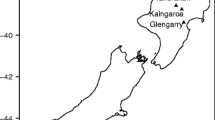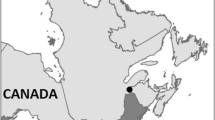Abstract
Pinus radiata D. Don trees were grown in the presence and absence of the woody weed broom (Cytisus scoparius L.) on a dryland site for 2 years to determine the effects of competition from weeds on wood properties in juvenile trees. Wood property measurements made on cross-sections from the bark to the pith were scaled to convert results from distance to a time basis using sigmoidal equations fitted to monthly measurements of tree diameter. When averaged across the 2 years, the presence of the weeds significantly increased wood density (+11%), wall thickness (+6%) and modulus of elasticity (MOESS, +93%), and significantly reduced microfibril angle (MFA, −21%) and radial diameter (−8%). Radial growth rate was significantly correlated to wood density, and this relationship held across both treatment and age. At the seasonal scale, there was close correspondence between changes in MFA and growth rate. Ring width was significantly related to both MFA and MOESS at the annual scale. Although both of these relationships held across treatments, year significantly influenced the value of coefficients in the relationships. The results highlight the direct effects of the presence of weeds on wood properties and the need to consider silvicultural treatments appropriate for balancing gains in productivity with losses in wood quality for timber production.




Similar content being viewed by others
References
Baker JB (1973) Intensive cultural practices increase growth of juvenile slash pine in Florida sandhills. For Sci 19:197–202
Balneaves JM, McCord AR (1990) Gorse control: a trying experience at Ashley forest. FRI Bull 155:150–156
Bouriaud O, Bréda N, Le Moguédec G, Nepveu G (2004) Modelling variability of wood density in beech as affected by ring age, radial growth and climate. Trees 18:264–276
Cave ID, Walker JCF (1994) Stiffness of wood in fast grown plantation softwoods: the influence of microfibril angle. For Prod J 44:43–48
Cown DJ, Kibblewhite RP (1980) Effects of wood quality variation in New Zealand radiata pine on kraft paper properties. N Z J For Sci 10:521–532
Downes GM, Hudson IL, Raymond CA, Dean GH, Michell AJ, Schimleck LS, Evans R, Muneri A (1997) Sampling plantation eucalypts for wood and fibre properties. CSIRO Publishing, Melbourne
Downes GM, Evans R, Schimleck LR, Fritts HC (2000) The commercial cambium: understanding the origin of wood property variation. In: Savidge RA, Barnett JR, Napier R (eds) Cell and molecular biology of wood formation. BIOS Sci, Oxford, pp 325–336
Erikson HD, Arima T (1974) Douglas-fir wood quality studies. Part II: Effects of age and stimulated growth on fibril angle and chemical constituents. Wood Sci Technol 8:255–265
Evans R (1997) Rapid screening of microfibril angle in increment cores by x-ray diffractometry. In: Butterfield R (ed) Microfibril angle in wood. Proceedings of the IAWA/IUFRO international workshop on the significance of microfibril angle to wood quality. Westport, New Zealand, pp 116–139
Evans R, Ilic J (2001) Rapid prediction of wood stiffness from microfibril angle and density. For Prod J 51(3):53–57
Evans R, Downes G, Menz D, Stringer S (1995) Rapid measurement of variation in tracheid transverse dimensions in a radiata pine tree. Appita J 48(2):134–138
Gindl W, Grabner M, Wimmer R (2000) The influence of temperature on lignin content in treeline Norway spruce compared with maximum density and ring width. Trees 14:409–414
Goodman AM, Ennos AR (1996) A comparative study of the response of roots and shoots of sunflower and maize to mechanical stimulation. J Exp Bot 47:1499–1507
Green SR, Grace J, Hutchings NJ (1995) Observation of turbulent air flow in three stands of widely spaced Sitka spruce. Agric For Meteorol 74:205–225
Hiller CH (1964) Estimating size of fibril angle in late wood tracheids of slash pine. J For 62:249–252
Kear BS, Gibbs HS, Miller RB (1967) Soils of the downs and plains, Canterbury and North Otago, New Zealand. N.Z. Soil Bureau Bulletin No. 14, Dept. of Science and Industrial Research
Knowe SA, Nelson LR, Gjerstad DH, Zutter BR, Minogue PJ, Dukes JH (1985) Four year growth and development of planted loblolly pine on sites with competition control. South J Appl For 9:11–15
Kretschmann DE, Bendtsen BA, (1992) Ultimate tensile stress and modulus of elasticity of fast-grown plantation loblolly pine lumber. Wood Fibre Sci 24:189–203
Lindström H (1996) Basic density in Norway Spruce. Part III. Development from the pith outwards. Wood Fibre Sci 28:391–405
Lindström H (2000) Intra-tree models of basic density in Norway Spruce as input to simulation software. Silva Fenn 34:411–421
Lindström H, Evans JW, Verill SP (1998) Influence of cambial age and growth conditions on microfibril angle in young Norway Spruce (Picea abies [L.] Karst.). Holzforschung 52:573–581
Macdonald E, Hubert J (2002) A review of the effects of silviculture on timber quality of Sitka spruce. Forestry 75:107–138
Mäkinen H, Saranpää P, Linder S (2002) Effects of growth rate on fibre characteristics in Norway spruce (Pices abies (L.) Karst.). Holzforschung 56:449–460
Mason EG, Milne PG (1999) Effects of weed control, fertilisation and soil cultivation on the growth of Pinus radiata D. Don at mid-rotation in Canterbury. Can J For Res 29:985–982
Mason EG, Whyte AGD (1997) Modelling initial survival and growth of Pinus radiata in New Zealand. Acta For Fenn 255:38
Megraw RA (1985) Wood quality factors in loblolly pine. Tappi Press, Atlanta, p 88
Milne R (1991) Dynamics of swaying of Picea sitchensis. Tree Physiol 9:383–399
Mörling T (2002) Evaluation of annual ring width and ring density development following fertilization and thinning of Scots pine. Ann For Sci 59:29–40
Nambiar EKS, Sands R (1993) Competition for water and nutrients in forests. Can J For Res 23:1955–1968
Nelson LR, Zutter BR, Gjerstad DH (1985) Planted longleaf pine seedlings respond to herbaceous weed control using herbicides. South J Appl For 9:236–240
Nicholls JWP (1982) Wind action, leaning trees and compression wood in Pinus radiata D. Don Aust For Res 12:75–91
Pape R (1999) Influence of thinning and tree diameter class on the development of basic density and ring width in Picea abies. Scand J For Res 14:27–37
Pruyn ML, Ewers BJ III, Telewski FW (2000) Thigmomorphogenesis: changes in the morphology and mechanical properties of two Populus hybrids in response to mechanical perturbation. Tree Physiol 20:535–540
Raupach MR (1992) Drag and drag partition on rough surfaces. Boundary-Layer Meteorol 60:375–395
Richards FJ (1959) A flexible growth function for empirical use. J Exp Bot 10:290–300
Richardson B (1993) Vegetation management practices in plantation forests of Australia and New Zealand. Can J For Res 23:1989–2005
Richardson B, Vanner A, Ray J, Davenhill N, Coker G (1996) Mechanisms of Pinus radiata growth suppression by some common forest weed species. N Z J For Sci 26:421–437
SAS Institute Inc (2000) SAS/STAT User’s Guide: Version 8, vols 1, 2 and 3. SAS Institute, Cary, NC
Sarén MP, Serimaa R, Andersson S, Saranpää P, Keckes J, Fratzl P (2004) Effect of growth rate on mean microfibril angle and cross-sectional shape of tracheids of Norway spruce. Trees 18:354–362
Savva Y, Schweingruber F, Milyutin L, Vaganov E (2002) Genetic and environmental signals in tree rings from different provenances of Pinus sylvestris L. planted in the southern taiga, central Siberia. Trees 16:313–324
Snowdon P, Khanna PK (1989) Nature of growth responses in long-term field experiments with special reference to Pinus radiata. FRI Bull 152:173–186
Telewski FW (1989) Structure and function of flexure wood in Abies fraseri. Tree Physiol 5:113–121
Telewski FW, Jaffe MJ (1986) Thigmomorphogenesis: field and laboratory studies on Abies fraseri in response to wind or mechanical perturbation. Physiol Plant 66:211–218
Tsehaye A, Buchanan AH, Walker JCF (2000) Sorting of boxed-pith lumber for stiffness. J Inst Wood Sci 15:130–133
Walker JCF, Butterfield BG (1996) The importance of microfibril angle for the processing industries. N Z For 40:34–40
Watt MS, Whitehead D, Richardson B, Mason EG, Leckie AC (2003a) Modelling the influence of weed competition on the growth of young Pinus radiata at a dryland site. For Ecol Manage 178:271–286
Watt MS, Whitehead D, Mason EG, Richardson B, Kimberley MO (2003b) The influence of weed competition for light and water on growth and dry matter partitioning of young Pinus radiata, at a dryland site. For Ecol Manage 183:363–376
Watt MS, Kimberley MO, Richardson B, Whitehead D, Mason EG (2004) A juvenile tree growth model sensitive to competition from weeds: tested using Pinus radiata at two contrasting sites in New Zealand. Can J For Res 34:1985–1992
Wimmer R, Downes GM (2003) Temporal variation of the ring width-wood density relationship in Norway Spruce grown under two levels of anthropogenic disturbance. IAWA J 24:53–61
Wimmer R, Downes GM, Evans R (2002) Temporal variation of microfibril angle in Eucalyptus nitens grown in different irrigation regimes. Tree Physiol 22:449–457
Zhao W (1999) Growth and yield modelling of Pinus radiata in Canterbury, New Zealand. PhD thesis, University of Canterbury
Zobel BJ, van Buijtenen JP (1989) Wood variation—its causes and control. Springer series in wood science. Springer, Berlin Heidelberg New York
Acknowledgements
The project was funded by the Foundation for Research, Science and Technology (Contract no. C04X0202). The principal author was supported by Doctoral Scholarships provided by AGMARDT and Holt Forest Trust
Author information
Authors and Affiliations
Corresponding author
Rights and permissions
About this article
Cite this article
Watt, M.S., Downes, G.M., Whitehead, D. et al. Wood properties of juvenile Pinus radiata growing in the presence and absence of competing understorey vegetation at a dryland site. Trees 19, 580–586 (2005). https://doi.org/10.1007/s00468-005-0417-4
Received:
Accepted:
Published:
Issue Date:
DOI: https://doi.org/10.1007/s00468-005-0417-4




